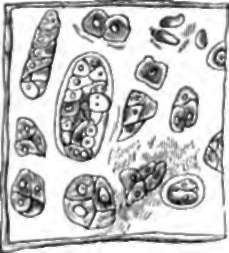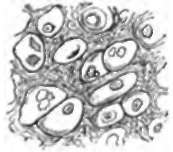21. Skeletal Textures
Description
This section is from the book "Animal Physiology: The Structure And Functions Of The Human Body", by John Cleland. Also available from Amazon: Animal Physiology, the Structure and Functions of the Human Body.
21. Skeletal Textures
The textures found in the skeleton are bone, cartilage, and the fibrous tissues. The fibrous tissues have been already considered. Bone, which is the prevalent texture in the adult skeleton, makes its first appearance always either in cartilage or fibrous tissue, more frequently in cartilage; therefore, it is convenient to explain the nature of cartilage first.
Cartilage, in its most frequent form distinguished as true or hyaline cartilage, is a firm texture capable of a marked amount of flexion, but breaking with a smooth fracture when it is sought to bend it further than its flexibility will allow. It presents, under the microscope, a clear or slightly granular matrix, with nucleated corpuscles imbedded in it, of variable size, and lodged, singly or in groups, in hollows, which are either of a rounded form, or with flattened sides and rounded angles, and are never branched. The limits of these hollows are denser than the surrounding matrix, and are termed capsules of the corpuscles. Cartilage is completely devoid of bloodvessels, for though occasional vessels occur in large masses, as, for example, in the costal cartilages, they are always lodged in canals along with a small amount of connective tissue. But the matrix is freely permeated by nourishment from the vessels round about; for cartilage is capable of rapid growth, and its growth is marked by changes throughout its substance. In growing cartilage, the corpuscles are seen in groups in every stage of multiplication. One will be found with two or more nuclei; another partially divided into two or more parts, with septa springing up between them; while, in other instances, the septa are completed, and exhibit various thicknesses of matrix between them, towards which the divided corpuscles still present flattened sides. The matrix of cartilage is converted by prolonged boiling, not into gelatin, but into chondrin, a closely allied substance, which, like gelatin, dissolves in hot water, and forms a jelly on cooling; but which differs slightly in composition, and has some distinctive chemical reactions. This is the more remarkable, as bone yields by boiling, not chondrin, but gelatin.
The coating of cartilage on surfaces of bone which glide one on another, is termed articular cartilage, and has the peculiarity that, towards the surface, the corpuscles are in groups flattened parallel to the surface, while in the deep parts they are in vertical groups.

Fig. 19. Costal Cartilage.

Fig. 20. Articular Cartilage. Vertical Section.

Fig. 21. Reticular Cartilage, from the Epiglottis.
A peculiar variety of cartilage, called yellow or reticular, which occurs in the epiglottis and a few other places, depends on the matrix being pervaded with a densely felted substance similar to elastic fibrous tissue, but more brittle.
Plates of matted fasciculi of fibrous tissue, with elements of cartilage sometimes interspersed, occur in various positions, but particularly as movable discs between the articular surfaces of certain joints, such as the knee, and combine the elastic resistance of cartilage with toughness which endures the action of rubbing, and are named fibro-cartilages.
Continue to:
